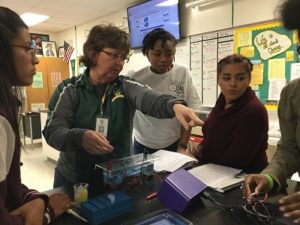By Lori Treiber, first published by Real Clear Education, November 23, 2016
 After 26 years of teaching, I was the model of a traditional teacher.
After 26 years of teaching, I was the model of a traditional teacher.
Class began with review, then new material and cooperative or independent work, then closure. But two years ago, intrigued by my district’s request that I pioneer an Opportunity Culture® biology blended-learning class, extending my reach to more students (and for more pay), I took the challenge: Could I learn some new tricks?
Yes. Just not the way I expected.
For the first semester in fall 2015, I extended my reach by seeing one group of students every other day, teaching a second group on the first group’s “off” days—nearly doubling my student load for this period to 46. I planned to cover two days of material during each face-to-face day—through labs and activities with minimal lecturing—while students worked online in the classroom on off days.
To “flip” the classroom, I recorded my usual lectures that summer, using PowerPoints and animations. I embedded questions in the videos to help students stay on track, and gathered remediation and enrichment resources.
I divided my students three ways: half met with me for half the period, while half worked online next door, then switched; half met with me for the whole period, switching the next day; or all 46 met together in a large room. I could design each day to best fit students’ needs and each topic’s objectives.
I also gave students personal choice and some freedoms. I broke the assignments into 80 percent “basic work” and 20 percent “uPicks,” letting students select from an assignment list. Students got all assignments at the beginning of the topic and could set their pace. Basic work was due daily, uPicks any time before the test. Freedom, right?
I had thought through everything as best I could, but I had never taken an online course. What did I really know from the students’ perspective?
In fall 2015, I started with a semester-long honors biology course and immediately hit a big bump. Students provided their own devices, so I had to be a technology expert, trouble-shooting everything. What a nightmare.
Worse, students resisted. They complained about the workload and blamed the blending. I needed to convince them that it was hard just because it was biology—but this also made me take a step back: Was I really giving them choice and personalized learning?
After surveying my students after every topic to see what was and wasn’t working, I realized I had to change to truly personalize my spring course.
This time, the students had school-provided iPads, and what a difference this streamlining made, letting me focus on the course. I gave students credit for uPicks even without the basic work. I first thought they couldn’t learn the material if they didn’t watch my videos or read the online text. But after reading their comments, I realized I took the “personal” out of learning when I required completing one activity before giving credit for another.
This semester went more smoothly. I had hope. But I was still troubled by some of the student comments about “personalized learning.”
I realized I needed to move away from controlling how students learned—so I moved to a 50/50 split. The basic work contained only my video lectures and online textbook readings (half of my students liked the videos and half preferred reading). The other 50 percent came from online activities, which became the uPicks.
Now students had more freedom to choose how to learn the material, and that worked well for the first quarter.
But what about the students who did not need all the practice—should I require them to do the assignments anyway? For second quarter, I decided they should have options, having been exposed to different ways to learn. So, based on previous test scores, they could decide whether to do graded pre-work. If they scored at least an 85 on the previous test, they could choose to do neither uPicks nor basic work for a recorded grade. But if they did no pre-work and the next test grade was below 85, then they lost the option for the next topic.
This did not lessen my workload, because most still submitted work for grades and feedback. On test day, they could tell me whether to record those grades or not.
They learned to choose what worked for them to learn the material.
Their basic work and uPicks were scored as one grade each. So unless they completed all the work, they chose for me not to record the score. This worked for some, but other students were not making the right decisions, which showed in their grades, as those who didn’t complete the work and didn’t want the grade recorded also didn’t do as well on tests, which became weighted more in their overall grades.
In spring 2016, I adapted the course further. My students are sophomores; giving them complete freedom without guiding them sets them up for failure. So, during the first quarter, they did not have any options. I taught them the value of practicing with new information in many formats, figuring out how they learned best. Second quarter, they had options. Now, though, they had to make a 90 on the previous test to have neither basic nor uPick work scored. With an 85 to 89, they earned the option not to do uPicks for a grade.
This worked. Students strove for higher grades to get choice, while taking responsibility and personalizing their own learning. I introduced them to many ways to learn and the skills to be self-sufficient learners. The course evolved to most benefit students.
But evolution never stops. Who knows how the course—and this not-so-traditional teacher—will evolve next?
